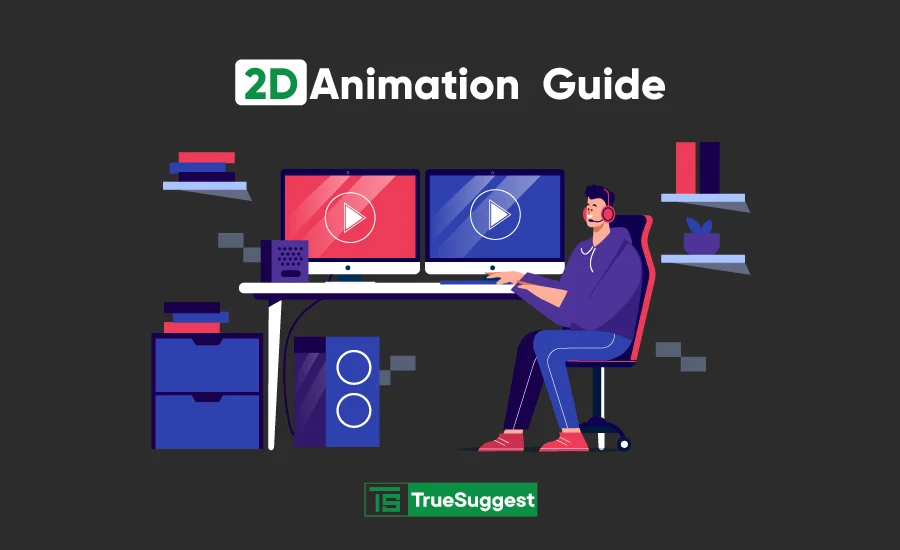What Is 2D Animation? - A complete package

2D animation is experiencing a significant resurgence, becoming increasingly popular across various media. You can find it prominently in TV shows, video games, feature films, advertisements, mobile apps, and websites. Notable modern examples include TV shows like Rick and Morty and F is for Family. Platforms like Snapchat are also embracing this trend, launching 2D animated series with short, snappy episodes lasting 1-3 minutes. Additionally, there has been a recent boom in 2D platform video games, with Cuphead being a prime example.
"Animation is used for everything online—advertising, entertainment—even if you don't realize it initially," says Scott Claus, 2D Animation Mentor at CG Spectrum. "The medium is evolving quickly. Television animation has taken off, and streaming services are constantly looking for new content
In this blog, we will learn what is 2d animation and the full details about it and why is still important.
What Is 2D Animation?
2D animation, or two-dimensional animation, is a form of animation where characters, backgrounds, and other elements are created in a two-dimensional space. This technique relies on drawing frames in a sequence to create the illusion of movement. Traditional 2D animation is hand-drawn, but modern techniques often use computer software to streamline the process. The result is a flat image with only height and width, unlike 3D animation which includes depth. 2D animation is widely appreciated for its stylistic versatility and its ability to convey stories and emotions effectively.
What is the Main Difference Between 2D and 3D Animation?
The primary difference between 2D and 3D animation lies in the dimensional space in which the animation exists. While 2D animation is created in a flat, two-dimensional space, 3D animation is crafted in a three-dimensional environment, giving it depth and a more realistic appearance.
1. Creation Process
In 2D animation, artists draw or design characters and backgrounds frame by frame. These frames are then sequenced to produce movement. Traditional methods involve hand-drawing on paper or celluloid, but modern 2D animation often uses vector-based software such as Adobe Animate or Toon Boom Harmony. The process is time-consuming and requires meticulous attention to detail to ensure smooth motion.
Conversely, 3D animation involves modeling characters and environments in three-dimensional space using specialized software like Blender, Maya, or 3ds Max. Animators then rig these models with a digital skeleton, allowing them to move in a lifelike manner. The rendering process adds textures, lighting, and shading to give the animation a more realistic look.
2. Visual Style
2D animation has a unique, often more stylized look due to its flat nature. It can range from simple and cartoonish to highly detailed and artistic. This style is perfect for conveying a wide range of emotions and storytelling techniques, often drawing on the expressive potential of the drawn line and color palette.
3D animation, however, aims for a more realistic representation. The added dimension of depth allows for more complex scenes and lifelike characters. This realism makes 3D animation ideal for creating immersive worlds, such as those seen in video games and blockbuster films. The detailed textures, lighting effects, and shadows contribute to a more lifelike and tangible viewing experience.
3. Movement and Physics
The movement in 2D animation is often more exaggerated and stylized. Animators can bend the rules of physics to achieve the desired effect, creating more fantastical and imaginative sequences. The flat nature of 2D also means that animators must work harder to convey depth and perspective.
In 3D animation, movement tends to be more realistic due to the software's ability to simulate real-world physics. Characters and objects move naturally within a three-dimensional space, and animators can apply principles like gravity, weight, and momentum to enhance realism. This allows for more subtle and nuanced movements, contributing to the believability of the animated world.
4. Tools and Techniques
2D animation uses tools such as light tables, peg bars, and traditional drawing supplies in its hand-drawn form. In digital 2D animation, vector graphics software and raster graphics software are employed. Techniques like tweening (intermediate frames creation) and onion skinning (seeing multiple frames at once) are common.
3D animation, on the other hand, relies heavily on computer software that can handle complex modeling, rigging, and rendering tasks. Techniques such as motion capture, where real actors' movements are recorded and translated into the animation, are also used to achieve more lifelike motion.
5. Applications and Usability
2D animation is widely used in television shows, web animations, commercials, and educational content due to its cost-effectiveness and faster production times.
It is also popular in mobile games and apps, where simple and engaging graphics are essential.
3D animation is predominant in feature films, video games, virtual reality, and architectural visualizations. Its ability to create realistic, immersive environments makes it ideal for these applications, despite its typically higher cost and longer production times.
In summary, while 2D animation offers a stylized, artistic approach with a focus on creative expression and simplicity, 3D animation provides a more realistic and immersive experience, utilizing advanced technology to create detailed and lifelike worlds.
2D animation types and techniques in Details
Stop-Motion Animation
Stop-motion animation involves physically manipulating objects in front of a camera to create the illusion of movement. This technique is used in both live-action and computer-generated animations, commonly appearing in television shows and video games. Claymation, often seen in children's shows, is a well-known example of stop-motion animation.
Frame-by-Frame Animation
Frame-by-frame animation requires drawing each frame of an animation separately as part of a series. These frames are then played back in rapid succession to produce the illusion of motion. This method is ideal for creating complex animations with many moving parts.
Cutout Animation
Cutout animation involves selectively removing and replacing parts of an animated character or object to simulate movement. This technique is frequently used in cartoons and animated films, offering high control over the shape, color, and size of the animated elements.
Rotoscoping
Rotoscoping traces over live-action footage to create an animated version. This technique can mimic realistic movements or generate stylized effects. Early cinematic animation films, which were hand-drawn over live-action footage, are classic examples of rotoscoping.
Computer Animation
Computer animation involves creating digital versions of hand-drawn or 3D models, then manipulating them on the computer to achieve the desired movement and look. This technique is often used in advanced video games and animated films because it allows for great flexibility and detail in the animation process.
Where is 2D Animation Used?
2D animation finds applications across various industries and media due to its versatility and cost-effectiveness. Here are some of the primary uses:
Product Commercials (Animated Ads)
2D animation is commonly used in advertisements to create engaging and memorable commercials that can quickly convey a product's features and benefits.
Educational Films
Educational content benefits from 2D animation by simplifying complex concepts and making learning more interactive and fun.
Feature Films
Full-length animated movies utilize 2D animation to tell captivating stories. Classic examples include Disney films like "The Lion King" and "Beauty and the Beast."
Short Feature Films
Short films that are longer than 30 minutes but less than 60 minutes often use 2D animation to deliver concise and impactful narratives.
Short or Experimental Subjects
Films shorter than 30 minutes, often seen in festivals or as pilots for larger projects, leverage 2D animation to experiment with new techniques and storytelling methods.
Video Games
Many video games, especially indie titles, use 2D animation for its stylistic appeal and lower production costs compared to 3D animation.
Video Game Trailers
Trailers for games often employ 2D animation to create exciting previews that highlight gameplay and storyline elements.
Architectural Animation
Architectural firms use 2D animation to create visualizations of buildings and spaces, helping clients understand designs before construction.
Medical or Other Industrial Films
In industries like healthcare, 2D animation simplifies the explanation of complex procedures and machinery, making it easier for professionals and patients to understand.
Multi-Path Movies
Interactive films where viewers can choose different paths for the story often use 2D animation due to its adaptability and ease of creation.
Logos, Intros, and Credits
2D animation is ideal for creating dynamic logos, introductions, and credits for various media projects, providing a professional and polished look.
Mobile Phone Images
2D animation is used in mobile apps and games to create engaging graphics and user interfaces.
TV Series
Animated TV shows, especially those aimed at children, frequently use 2D animation due to its vibrant and expressive style.
TV Specials
Special one-hour TV programs use 2D animation to create unique and memorable viewing experiences.
Television Bumpers
Short segments that introduce or conclude TV programs use 2D animation for their brief and eye-catching designs.
Music Videos
Musicians often use 2D animation in music videos to create visually striking and memorable pieces that complement their songs.
Web Animation
The internet is filled with 2D animated content, from web series to animated GIFs, making it a popular medium for online creators.
Why is 2D Animation Important?
2D animation holds a significant place in the world of media and entertainment for several reasons. Its importance stems from its historical roots, versatility, accessibility, and unique ability to convey emotions and stories effectively.
Historical and Cultural Significance
2D animation has a rich history that dates back to the early 20th century. Classic animated films and TV shows have left an indelible mark on popular culture, influencing generations of viewers. Iconic characters and stories from studios like Disney have become cultural touchstones. The hand-drawn artistry of traditional 2D animation is highly valued, with many modern works paying homage to these early styles and techniques. This cultural heritage ensures that 2D animation continues to be celebrated and appreciated worldwide.
Cost-Effectiveness
One of the most significant advantages of 2D animation is its cost-effectiveness. Compared to 3D animation, 2D requires fewer resources and less time to produce. This makes it an attractive option for smaller studios, independent creators, and projects with limited budgets. The lower production costs also allow for more creative risk-taking and experimentation. Independent artists can produce high-quality animations without needing extensive financial backing, leading to a more diverse range of content.
Simplicity and Accessibility
The simplicity of 2D animation makes it accessible to a wide range of creators. With basic drawing skills and the right software, almost anyone can start creating 2D animations. This democratization of the medium has led to a surge in independent animated content, allowing diverse voices and unique stories to reach audiences worldwide. Online platforms and social media have further amplified this trend, giving creators a global stage to showcase their work.
Versatility in Style
2D animation offers unparalleled stylistic versatility. Artists can create everything from simple, cartoonish characters to detailed and intricate designs. This flexibility allows 2D animation to adapt to various genres, themes, and audiences. Whether it's a children's TV show, a dark and gritty graphic novel adaptation, or an educational video, 2D animation can effectively convey the desired tone and message. The medium's ability to exaggerate movements and expressions helps convey emotions and actions clearly and effectively.
Strong Storytelling Potential
2D animation excels at storytelling. The medium's ability to exaggerate movements and expressions helps convey emotions and actions clearly and effectively. This makes it an excellent choice for narrative-driven content, where character development and emotional engagement are crucial. Iconic animated films and series often owe their success to the powerful storytelling made possible by 2D animation. The simplicity of 2D visuals allows audiences to focus on the story and characters, fostering a deep emotional connection.
Educational Value
In educational contexts, 2D animation is an invaluable tool. It can simplify complex concepts, making them more accessible and understandable for learners of all ages. Animated educational videos can engage students and enhance retention by presenting information in a visually appealing and memorable way. Subjects ranging from science and mathematics to history and language arts benefit from the clarity and engagement that 2D animation provides.
Artistic Expression
2D animation provides a platform for artistic expression. Animators can experiment with different styles, techniques, and narratives, pushing the boundaries of what animation can achieve. This creative freedom leads to innovative and visually stunning works that inspire and entertain. The hand-drawn nature of traditional 2D animation allows for a personal touch that can be deeply expressive and unique.
Final Notes
In conclusion, 2D animation remains a vital and impactful medium in the world of entertainment, education, and beyond.
Its cost-effectiveness, simplicity, versatility, and strong storytelling potential make it an enduring and beloved form of animation.
The emotional connection it fosters with audiences, along with its rich cultural heritage, ensures that 2D animation will continue to be an important and cherished medium for years to come






























